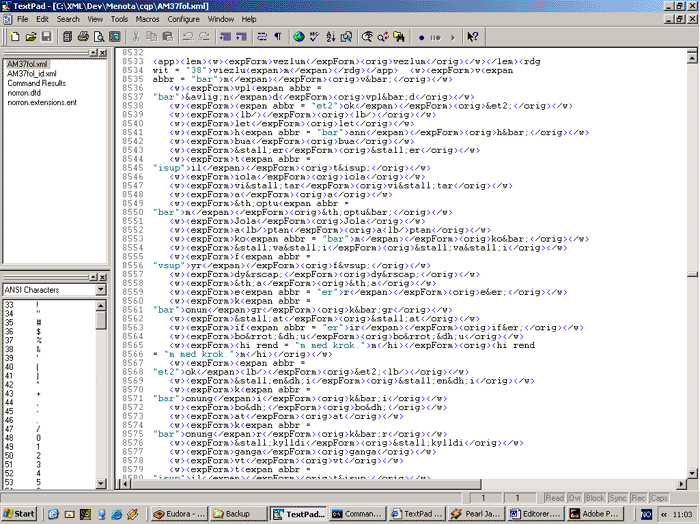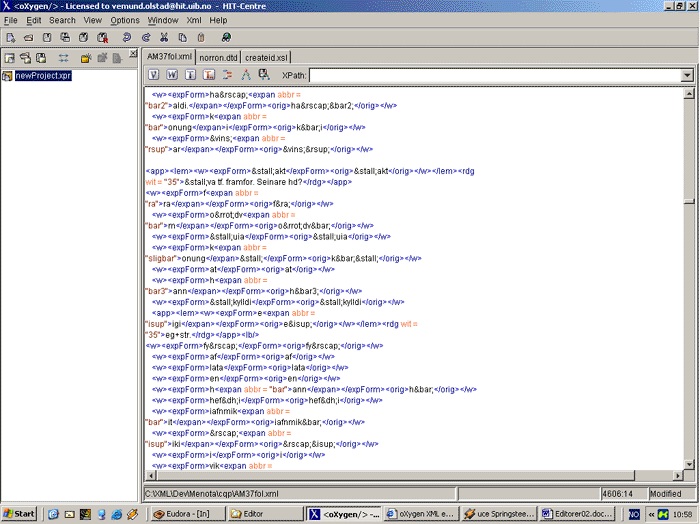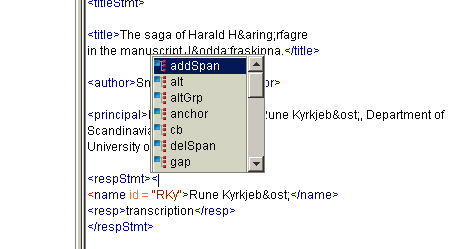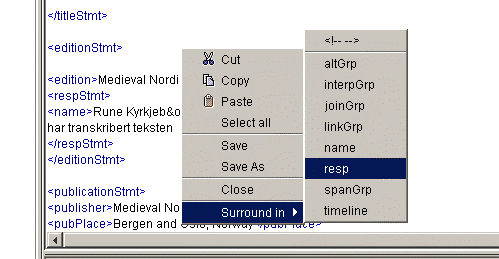
Version 1.1 (5 May 2004)
In order to write and edit XML one needs some sort of editing tool. Due to the nature of XML almost any text editing tool can be used, but there are also some specialised editors on the market. The decision on what kind of editor to use depends more or less entirely on personal preference and what kind of software the individual users are familiar with. There is no reason why a person cannot use Microsoft Word to edit or encode XML if he or she wishes - if that is the preferred editor for document editing.
The suggestions made below are only meant to be a guide to what we feel are convenient tools. For each of the editors we describe, there are probably a large number of almost identical alternatives, but these are the XML editing tools we have made use of and feel comfortable recommending to others.
Operating system: Windows 95 / 98 /
NT / ME / 2000 / XP
Version: 4.5
Price: USD 27 (single user)

![]() Full
size image (1025 x 768
pixels)
Full
size image (1025 x 768
pixels)
Description
TextPad is basically a general text editor similar to the built-in Notepad in Windows. The main difference between these two editors is that TextPad has a number of additional functions that make text editing somewhat easier than in Notepad. Among the many extra functions are:
Unlimited undo/redo function. As opposed to many other editors that only remember the last command given, there is no limit to how far back you can go with the undo function i TextPad.
Expanded search and replace. TextPad does not only have the ability to do search and replace in text, but it can also search for regular expressions like tabulator, linebreak and space.
A built-in "file manager" that makes it easier to edit several documents simultaneously.
In addition to the numerous built-in functions there are a large number of programs that are made by TextPad users to extend the functionality of the program. Among the many add-ons we find a program that "cleans up" superfluous tabulators and blank lines and an option to run the Expat XML parser within TextPad. When it comes to XML support, TextPad has the ability to run DOS-commands from a menu. This basically means that validation of XML files with an external program like Xerces can be done without having to go to the command prompt. Command results are brought up in a file of its own in the file manager window.
Another useful function in TextPad is the ability to use so-called "clip libraries". In the context of HTML/XML this means that the user can be given a list of all tags in a particular code language in a menu. Instead of typing the tags, they can just be selected from the menu and inserted into the text. Examples of existing "clip libraries" are: Dublin Core, HTML 4.0 and LaTeX. For Menota the biggest advantage of such clip libraries would probably be to create menus for the extensive entity list.
Operating system: Windows / Mac /
Linux / Solaris
Version: 3.1 (as of 6 February 2004)
Price: USD 48 (single user - academic version)

![]() Full
size image (1025 x 768
pixels)
Full
size image (1025 x 768
pixels)
Description
<oXygen/> is a pure XML editor and does therefore have quite a few specialised functions that are not normally found in a general text editor of the kind TextPad represents. <oXygen/> is, in many ways, similar to editors like XML Spy og Xmetal, but it has some functions that, in our view, makes it a class apart from these editors.
This program is, like many other XML-related programs, written in Java and therefore available on most platforms, provided the computer has a Java environment installed. Like most specialised XML editors, <oXygen/> has built-in functions to check for well-formedness and validity of the file you are working with. It is also possible to run XSLT and FOP transformations from within the editor, and it has full Unicode support (also on the Mac platform).
The biggest single advantage in this editor when you compare it to others, however, is the so-called "Code-insight" system which it uses. If the document being edited is connected to a DTD (or XML Schema), the editor will be able to read this and "understand" the structure of the document. During text editing, context sensitive menus will be available - allowing for auto-completion of XML tags and attributes. This eliminates a lot of manual coding and makes editing easier for the author (see illustrations below).


In addition to being context sensitive to existing DTD's, the program also has the ability to "learn" the document structure of an XML file and build its own DTD if there is not one present already. oXygen also has colour coding of the file formats it supports, and this can be changed to suit the users' preferences.
This editor is, in many ways, similar to emacs, which is a commonly used editor within the SGML/XML community - but it is somewhat easier to install and use.
|
Version 1.0 published 20 May 2003. Version 1.1 published 5 May 2004. |